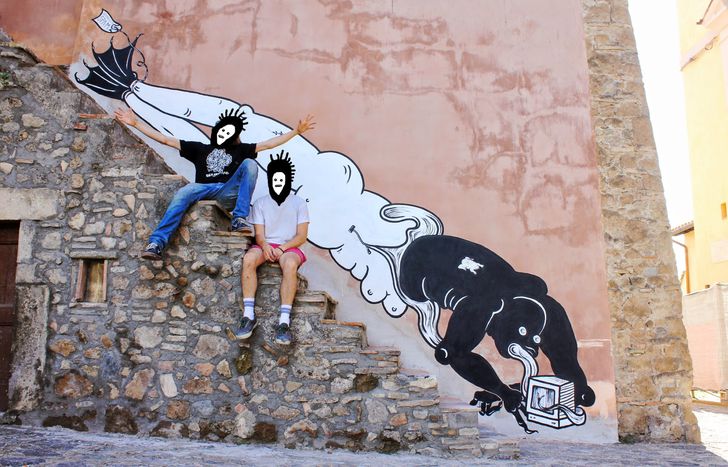
Guerrilla Spam Exists! The art that attacks the streets
Published on
Translation by:
Irena MatuteA few years ago they started invading the Italian and European cities with their original graffiti’s, unauthorized shows and provocations, but above all with ironic, sharp and socially engaged art. But what is actually behind an anonymous group of artists born in Florence in 2010? We have reached them virtually. Apparently, Guerrilla Spam does exit as you will find out more in this interview.
CB: How was Guerrilla Spam born?
Step by step and without any intent and I like that a lot. We met in Florence, the first year at university, and we become friends because we shared many interests and even our apartment. One night we went out on the street to post a design made the previous day. We had a lot of things to say and we were having fun by doing so. We continued posting designs at night for the next few months until we realized that we need to find a name. The name we came up with was: Guerrilla Spam.
CB: And the idea of your attacks and the combination of the two concepts such as "guerrilla" and "spam"?
Guerrilla is our course of action, unauthorized wild-posting, delivered impetuously and imposed on viewer’s eyes; and spam because our messages are like e-mail spam, sudden and unexpected. You receive it whether or not you requested it.
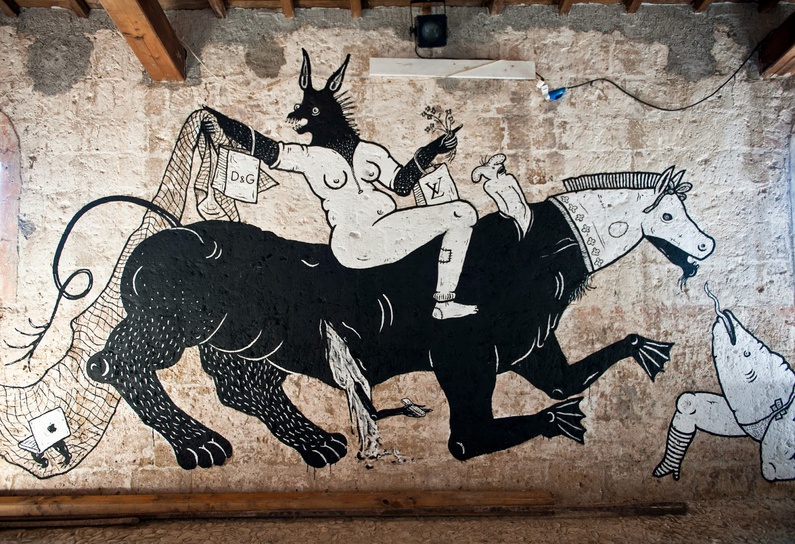 CB: You "attack" for almost four years, but why do you remain anonymous? Why "Guerrilla Spam" does not exists?
CB: You "attack" for almost four years, but why do you remain anonymous? Why "Guerrilla Spam" does not exists?
Being anonymous is the base of our work. The spam does not exist; or it does but if it exists then what is it? We are an undefined group of people in which age, sex and appearance are unimportant. We remain anonymous because people shouldn’t focus on us but on what we produce. The discussion of legal risks is subsequent, and we are interested in emphasizing that we are anonymous because we give priority to the content in respect to the person.
CB: Reading your "manifest" it caught my eye the war against the massive power of the media campaign of disinformation. Why this contradiction? In many occasions in your work the TV screen appears, what does the television represent for you?
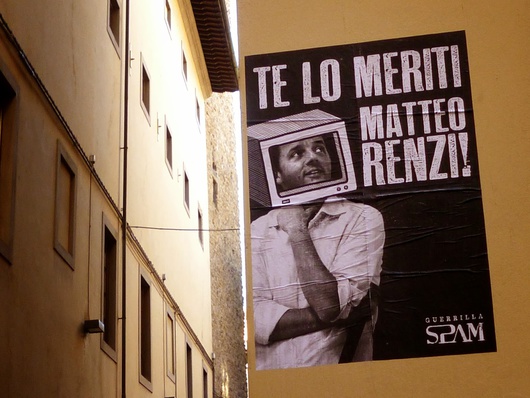 It is a phrase a bit 'exaggerated, but makes good concept of what we propose to do. The discourse on the television is inflated but concrete and dramatically present in Italy. The TV creates communication unilaterally, and in an official way. Its message cannot be evidently interpreted by a small user of information (or disinformation), whose real power, besides the presumed "possibility of choice", is the one to ignore the television. We communicate in unauthorized and unofficial ways in public places producing messages that can be "touched" and manipulated, captured, deleted or removed, by the viewer. It`s true, we impose in the urban space, but at the same time the viewer can act on our work with the same vehemence and enforcement as we did; the citizen, instead of being passive, in front of what we attack, should be obliged to react. Actually, if he wants, he can do it.
It is a phrase a bit 'exaggerated, but makes good concept of what we propose to do. The discourse on the television is inflated but concrete and dramatically present in Italy. The TV creates communication unilaterally, and in an official way. Its message cannot be evidently interpreted by a small user of information (or disinformation), whose real power, besides the presumed "possibility of choice", is the one to ignore the television. We communicate in unauthorized and unofficial ways in public places producing messages that can be "touched" and manipulated, captured, deleted or removed, by the viewer. It`s true, we impose in the urban space, but at the same time the viewer can act on our work with the same vehemence and enforcement as we did; the citizen, instead of being passive, in front of what we attack, should be obliged to react. Actually, if he wants, he can do it.
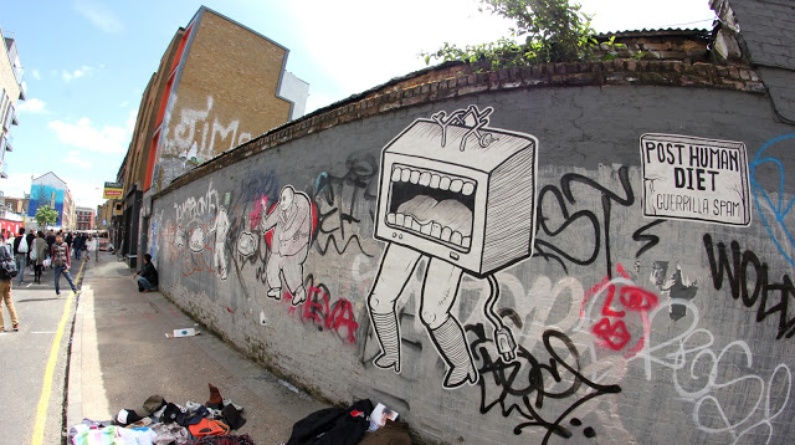 CB: What are your artistic influences? Why black and white?
CB: What are your artistic influences? Why black and white?
The black and white are an affordable and stylish choice. The low price of the photocopy has allowed us to print large quantities of designs and post them in series.
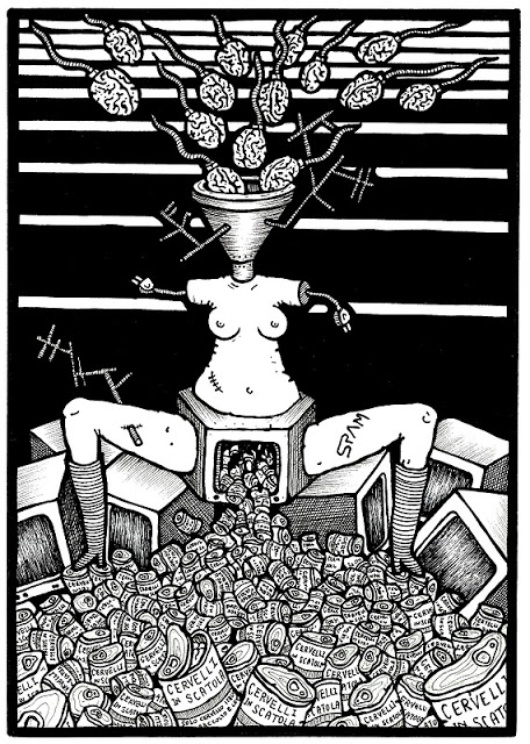 Also it has an impact on the urban environment because it differs totally from the billboards, the advertising, and the color abuse signs. Anything but attractive and ineffective. We love authors such as Durer and Goya, but we also get quotes and ideas from artists like Pontormo, Dali, Bosch and Bruegel. It is useless to say that, in the urban art environment, the focus of our work is Blu, whether it`s the subject or the style.
Also it has an impact on the urban environment because it differs totally from the billboards, the advertising, and the color abuse signs. Anything but attractive and ineffective. We love authors such as Durer and Goya, but we also get quotes and ideas from artists like Pontormo, Dali, Bosch and Bruegel. It is useless to say that, in the urban art environment, the focus of our work is Blu, whether it`s the subject or the style.
CB: In your opinion, what are the reactions of your audience, of the pedestrians that run across your work?
The reactions are always different, there are those who are annoyed and those who appreciate our work. Usually, people are shocked by our vehemence. But as Pasolini said, you have to find "pleasure in being scandalized", so we are raising the dose. Before posting a series of designs on the streets in Milano, we recently exposed our work related to artists` suicide on exhibition at Galo Art Gallery in Turin. The designs were pretty macabre and dramatic, a little violent and also splatter, but fundamentally everything was covered with subtle irony. There were crucified artists on painting easels, some were committing a suicide by drinking gallons of acrylic paint, and others were making themselves explode by setting spray cans on fire. Even the children that were passing were laughing and understood the irony. If anything, it was the adults that were shocked, approaching with fear, some even just looking without entering.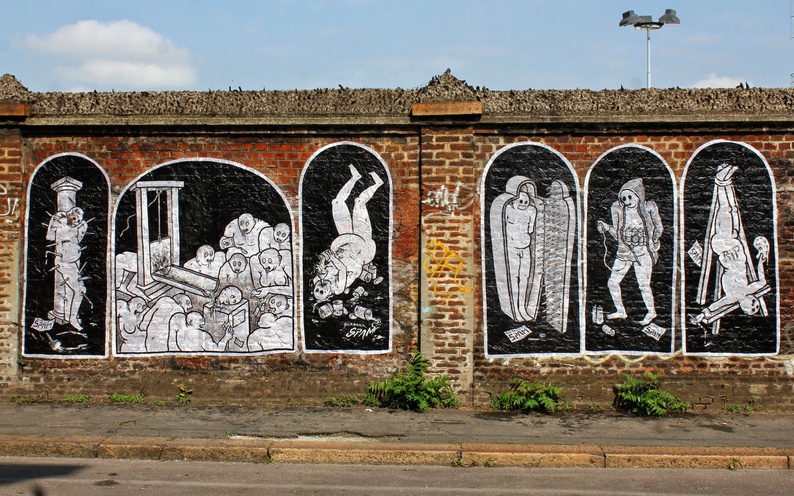
CB: Speaking of Street Art, don't you think that today this phenomenon of global diffusion is losing the "original purity" and it's becoming too inflated?
It is always dangerous to speak of purity. It's a bit 'as the discourse of "beauty sitting on the lap" of Rimbaud, of which Dali said that he is tired. We shouldn’t care about purity, otherwise we'll enter the depraved circle of debates such as "graffiti purists against street art", "street purists against art gallery" and so on. The first ones in England that started making stencils were seen as "toy" from the pure graffiti artists, but thankfully, they started doing new things.
CB: What is then street art?
Nowadays, what people call "street art" is a mix of various elements and it is obvious that it has become a pop, mass phenomenon. We are quite far from the old underground and alternative matrix original. Where are the artists today who walk around together to draw at night? Today, they work on legal graffiti walls for organized events. They give privilege to festivals, events and major official exhibitions.
CB: Why?
Uban art was incorporated into the traditional system, as it was obvious that this would happen. But the thing is that, as the time has changed, the artists started supporting this trend in other places and neglecting the street. There is no need of criticizing the "in" street art circuit; the exhibitions, events and festivals are decent, but we have to recover the attitude for those who "work" on the streets, otherwise we should stop saying that we are doing street art because its "cool" and say that we are doing traditional contemporary art.
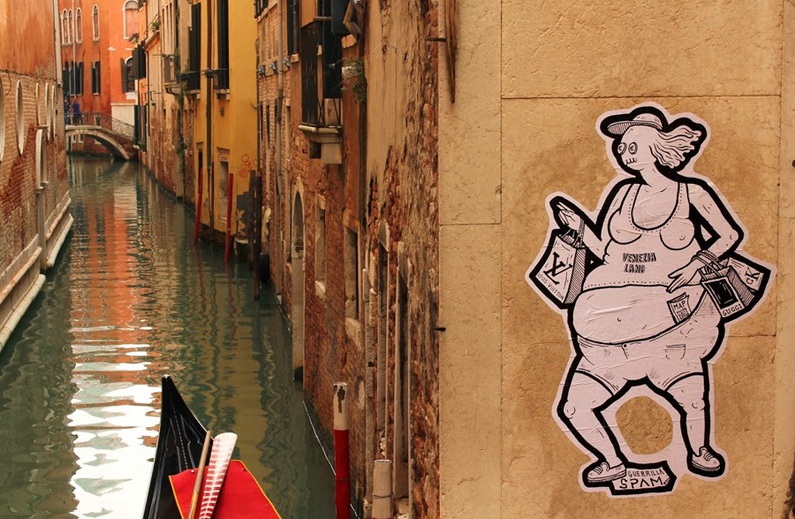 CB: Recently you've attacked Spain, what are your future plans? Are you going to leave the national border, and start attacking Europe or even outside the Old Continent?
CB: Recently you've attacked Spain, what are your future plans? Are you going to leave the national border, and start attacking Europe or even outside the Old Continent?
We posted ninety drawings in Barcelona, Valencia and Madrid, after that we returned to Spain and went close to Viterbo, S. Michele in Teverina; now we are at Hogre`s in Rome who besides being a friend is also an artist which we appreciate a lot and who shares with us the attitude marked on the street. After that we have a new program for Florence, Turin, Portugal and probably Switzerland. All of this will happen till September-October; we are also working for months on a major unauthorized event which will take place next November in Turin. It will be the second edition of "Shit Art Fair", which we created last year, by abusively posting 130 meters of paper inside a tunnel in Turin.
CB: What is it about?
This new show will be an illegal event of great importance because there will be many other Italian street artist. The spirit will be to create something in common, self-coordinated by the artists themselves, without the help of administrator and organizations or festival in a setting totally unauthorized. We'll be our own sponsor and we`ll create a public exhibition for the citizens on a place available for everyone.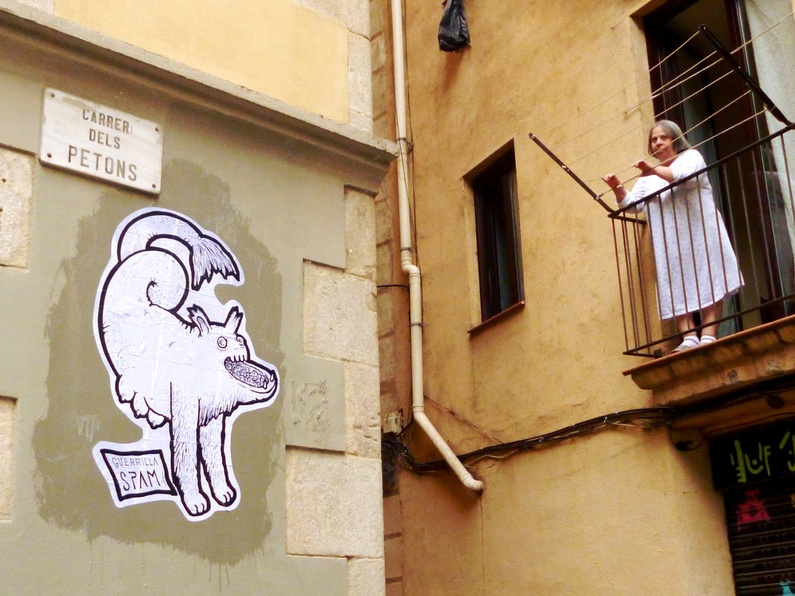
Translated from Guerrilla Spam Esiste! L'arte che attacca la strada



